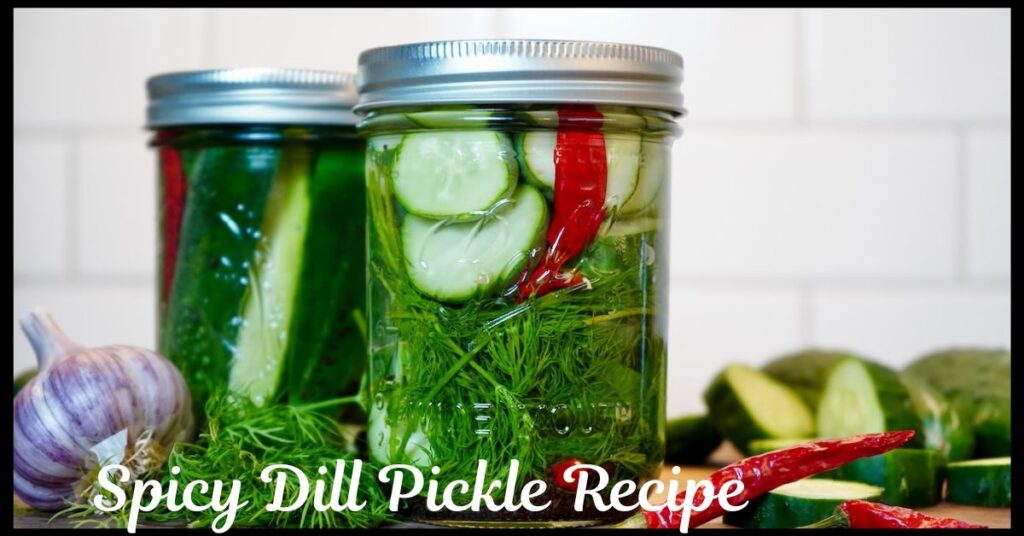Dill pickles are a timeless staple in many households, known for their tangy, crisp flavor. Adding a spicy twist enhances the traditional profile, creating a bold, flavorful snack or accompaniment that excites the palate. A spicy dill pickle recipe combines the freshness of cucumbers with garlic, dill, vinegar, and heat-inducing ingredients like chili flakes or jalapeños. This article provides a complete, step-by-step guide to making spicy dill pickles at home with accessible ingredients and simple techniques.
Table of Contents
ToggleBenefits of Homemade Pickles
Making pickles at home ensures control over ingredients, flavor intensity, and freshness. Unlike many store-bought varieties that may contain preservatives or artificial additives, homemade pickles can be tailored to specific dietary preferences.
Nutritional Benefits
Pickles, when made with vinegar and fresh vegetables, are low in calories and can be a source of probiotics when naturally fermented. According to a study published by the National Center for Biotechnology Information (NCBI), fermented foods, including pickles, can support gut health by promoting beneficial bacteria source.
Ingredients for Spicy Dill Pickles
Essential Ingredients:
- Fresh cucumbers (Kirby or Persian cucumbers are ideal): 6–8 small cucumbers
- Fresh dill sprigs: 4–6
- Garlic cloves: 4, peeled and slightly crushed
- White vinegar (5% acidity): 2 cups
- Water: 2 cups
- Kosher salt or pickling salt: 2 tablespoons
- Sugar (optional, for balanced flavor): 1 teaspoon
For the Spice:
- Red pepper flakes: 1 teaspoon (adjust for heat level)
- Black peppercorns: 1 teaspoon
- Sliced jalapeños or serrano peppers: 1–2
- Mustard seeds: 1 teaspoon
Equipment Needed
- Glass jars with airtight lids (quart-size or pint-size)
- Saucepan
- Tongs or jar lifter
- Funnel (optional for ease of pouring)
Proper sterilization of jars is important to ensure shelf stability. Boil jars and lids for at least 10 minutes before using.
Step-by-Step Instructions
Step 1: Prepare the Cucumbers
Wash cucumbers thoroughly and slice them as desired—either into spears, rounds, or keep them whole if they are small enough to fit in jars.
Step 2: Sterilize Jars
Place clean jars in boiling water for 10 minutes to eliminate bacteria. Dry completely before use.
Step 3: Make the Brine
In a saucepan, combine vinegar, water, salt, and sugar. Heat the mixture over medium-high heat until it reaches a gentle boil and the salt dissolves. Remove from heat.
Step 4: Pack the Jars
In each sterilized jar, layer:
- A few dill sprigs
- One or two garlic cloves
- A few peppercorns
- A portion of sliced jalapeños or pepper flakes
- Mustard seeds
Then pack the cucumbers tightly into the jars without crushing them.
Step 5: Add the Brine
Carefully pour the hot brine into the jars using a funnel, ensuring the cucumbers are fully submerged. Leave about ½ inch of headspace at the top of each jar.
Step 6: Seal and Store
Seal the jars with lids. Allow the jars to cool to room temperature. Store in the refrigerator for quick pickles (ready in 24–48 hours) or process them in a hot water bath for long-term storage.
Step 7 (Optional): Water Bath Canning
For shelf-stable pickles:
- Place filled jars in a boiling water canner.
- Ensure jars are covered with 1 inch of water.
- Boil for 10 minutes (adjust for altitude if necessary).
- Carefully remove and cool jars on a towel. Check seals after 24 hours.
Storage and Shelf Life
- Refrigerator Pickles: Last 2–3 months in the fridge.
- Canned Pickles: Store in a cool, dark place for up to 12 months.
Always refrigerate after opening. If the seal is broken or signs of spoilage (e.g., mold, off-smell) are noticed, discard the pickles.
Tips for the Best Spicy Dill Pickles
- Use firm, fresh cucumbers to ensure a crisp bite.
- Avoid iodized salt, which can cloud the brine and affect texture.
- Slice jalapeños with seeds for maximum heat.
- Experiment with spices, such as coriander seeds, bay leaves, or crushed habaneros for different flavor profiles.
Common Variations
1. Sweet and Spicy Pickles
Add more sugar (2–3 tablespoons) to the brine for a tangy-sweet flavor balance.
2. Fermented Spicy Pickles
Skip the vinegar and use a saltwater brine (3 tablespoons salt per 1 quart water). Leave jars at room temperature (65–75°F) for 5–7 days, then refrigerate.
3. Extra-Garlic Pickles
Add more garlic cloves per jar for a stronger punch.
Safety and Best Practices
The USDA recommends using vinegar with at least 5% acidity for safe pickling [source: USDA Complete Guide to Home Canning]. Always use tested recipes and avoid altering vinegar-to-water ratios when canning.
Sterilization and proper sealing are critical to prevent botulism, a rare but serious illness caused by improperly canned low-acid foods.
Serving Suggestions
Spicy dill pickles pair well with:
- Sandwiches and burgers
- Charcuterie boards
- Tacos or grilled meats
- As a tangy snack on their own
For a gourmet twist, chop and mix pickles into potato salad or deviled eggs for added flavor and texture.
Conclusion
Crafting spicy dill pickles at home is a rewarding process that yields crunchy, flavorful results. With just a few simple ingredients and steps, anyone can enjoy homemade pickles tailored to their preferred spice level. Whether enjoyed as a snack or used to elevate meals, spicy dill pickles bring a zesty edge to everyday cuisine.
By following proper preparation and safety guidelines, these pickles can be stored for months, making them a convenient and delicious addition to any pantry.







